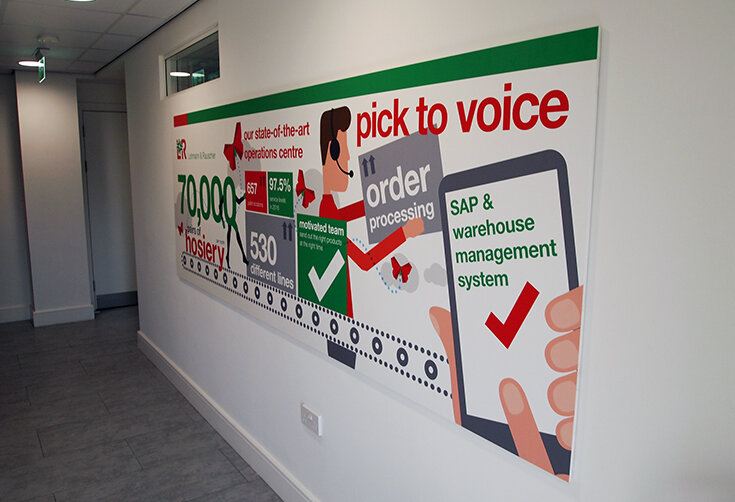Clear messaging for stakeholders
The word ‘stakeholder’ is used a lot, but who makes up your key stakeholders?
Take some time out to reflect on this; it’ll be worth spending time doing this on your own, and also asking colleagues or employees the same question to get a general ‘feel’ for the breadth of who your stakeholders are. Other people may come up with ideas you hadn’t thought about, especially those with their ‘ear to the ground’ as markets constantly evolve, change, and adapt over time.
You may hear the terms strategic messaging and strategic communication used. They both mean the same thing, really – messages sent out to all stakeholders involved in your business. Whether you or your colleagues use business jargon, or just express ideas in your way, that’s fine! At the end of the day, as long as you are all clear about who your stakeholders are, you’ll be heading in the right direction.
As a starting point, though, let’s think about your employees as stakeholders – your employees need to be your brand advocates, driving your business forward in full knowledge of your company’s brand values, ethos and visions. In fact, an excellent employee won’t just be aware of these factors; they will ‘believe’ in them. After all, your brand and company’s reputation is always at stake in a highly competitive business world, so make sure your colleagues are entirely on board with your brand. If your employees don’t believe in your brand, why should anyone else?
Next, let’s think about your customers – take the time to consider what these stakeholders are looking for carefully. Develop your brand to meet these needs. Today, customers have an array of companies to choose from. It may be worth thinking about what makes existing, or prospective consumers, ‘tick’; take their emotions and feelings into consideration when sending brand messages to customers. Remember, customers don’t just buy a product, process or service, they buy your vision, ethos and values. Look after them, and they will look after you.
Are your competitor’s stakeholders? Yes, they are, so try to keep on top of what their strengths are, as well as their weaknesses. How does their brand identity match up to yours? Are they doing anything different? Are there any new start-up companies in your sector, who may become a more prolific competitor in the future?
Also, are your suppliers, or distribution channels, on board with your brand? Make sure you are giving them explicit brand messages about your identity. Your good reputation will, in turn, benefit their businesses, too. They are more likely to remain a long-term strategic partner if they believe and fully buy into your brand.
What about your community? They are stakeholders in that what you do, and how you make the locality ‘look’ directly affects them. It is essential to make sure your community is happy with what you are doing; consider how highly Corporate Social Responsibility (CSR) is regarded now.
Two key ideas to leave you to think about are these:
1. Effective branding and messaging are consistent and straightforward.
2. All businesses communicate, but not every company sends clear messages to their stakeholders.
1st impressions count
Yes, they really do! It’s such an old cliché, but I just can’t ignore it, and neither should you.
Let’s consider a scenario. You’ve just walked into an exhibition centre filled with hundreds of stands. The businesses there will have spent varying amounts of money depending on the size of their budgets. Nevertheless, regardless of how much money a company has to spend, they can all achieve that magical first impression ‘spark’ with plenty of thought and planning into how they want their stand to look. You don’t need to spend thousands and thousands to attract your target audience, but what you do need is clear and consistent brand identity.
In fact, some companies spend lots of money and still manage to ‘get it wrong’ by not having a clear, crisp brand identity across their stand and all of their marketing collateral, such as brochures and flyers.
So, think back to the idea at the start of walking into the exhibition centre: Which stands are people stopping to look at, but they move on? Which stands are being ignored as if they don’t exist? Which stands are attracting and retaining the most traffic? Now consider – why?
If stands have boards that are just too ‘word-heavy’, no one will want to stand and read through it all. Less is more when it comes to content. Just have enough text to attract your audience to your stand. Once you start to talk to people, then they can learn more about you, and take a brochure away to read at their leisure.
Consider your logo, typeface, colours – do they ‘speak’ the message of your brand identity? As I mentioned earlier, your brand identity should be clear and consistent across the whole of your stand. Do your staff know your visions, values, and ethos? Are they clear about the company identity? Everyone needs to be giving a consistent company message to the visitors to your stand.
The use of a video to engage your audience is really beneficial. As well as attracting them to your stand, it can keep them there for a few minutes longer. It’s also helpful if you’re busy talking to other visitors, as people watching a video are more likely to wait for you to finish rather than walk away, as they are being entertained and informed.
Check your brand identity is consistent across your internal communications. This seems obvious, but many companies spend thousands and just forget about this. At the stand you may tell a potential client that you will email them a piece of information they are looking for – it will look pretty awful if the ‘old logo’ is in the email!
Please do ‘sweat the small stuff’: you never know who you are going to meet on your stand.
It could be your biggest customer ever!
How design can improve the effectiveness of internal communications
Have you ever worked for a company (or perhaps you are at the moment) where internal communications, such as notes and memos etc. sent around the offices looked…well…a bit dull really? Were they printed on plain white paper, with standard fonts, and perhaps not a logo or a hint of colour in sight? If yes, how did it make you or your colleagues feel?
A little reflection time may be needed for that last question.
The type of thoughts that may spring to mind could be along the lines of: ‘Doesn’t give the company a professional image’… ’Feels unimportant’… ’Makes the staff feel unimportant’… ’No cohesion’… ’People say they are too busy to bother… ’It doesn’t feel like we all belong to the same company’… ’Feels like nobody cares enough’.
It doesn’t matter whether it was a few years ago, or today, as humans we all want to feel part of the ‘team’, and that the team we are in is the best. It motivates and inspires us to work hard and do well.
Knowing our company’s mission, values and ethos help us to feel included in the bigger picture and goals of the company. We all want to be on the same boat, all rowing in the right direction.
So, we can make a start by ensuring all of our communications, external and internal, exude professionalism.
Develop a consistent design, tone and focus across all your internal communications, whether they are paper-based, or on your internal intranet. Embed your brand identity so that it is seen everywhere, every day, in your workplace. Also, don’t forget to include this consistent design across the interior landscaping of your buildings, such as wall displays and signage.
When onboarding new employees, educate them in your branding message; this is a great way to make them feel connected to the company straight away, and it is a discipline that will stay with them, and they will pass it on to others.
It’s worth asking a professional for advice when it comes to helping with your branding identity, rather than trying to save money by doing it yourself, as it may well turn out to be a false economy in the end.
It’s like anything really – if you want a professional ‘look’, you need a professional to do it.
Ensure everyone in your company feels inspired; give them a sense of belonging and pride.


